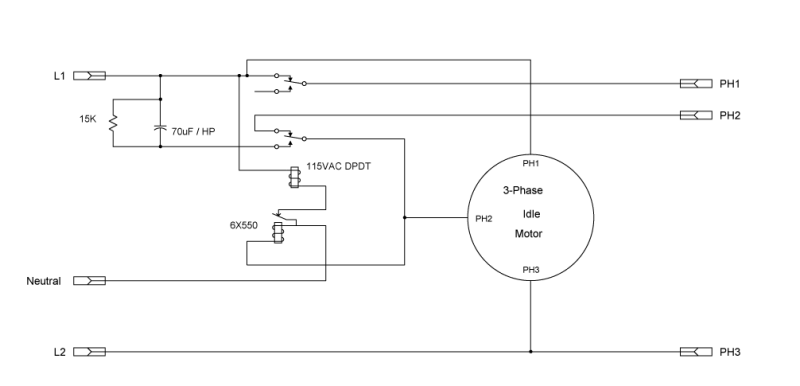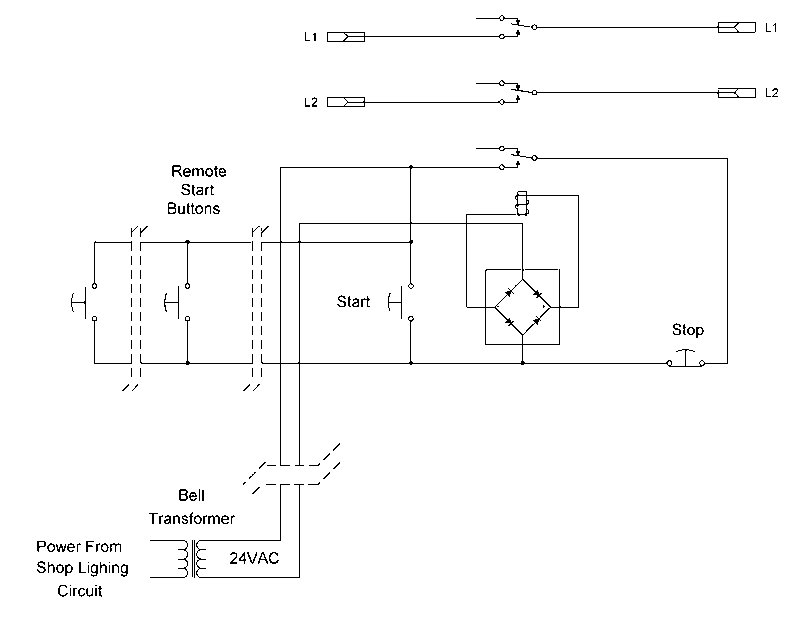Phase Converters and Starting Circuits
by George Carlson
This page contains links to several circuits for building phase converters and magnetic starters.
The converters are very simple but function well. They are designed to be easily constructed from readily available parts.
Use the static converter if you only plan to use a single 3-Phase motor, or where you wish to keep the machine portable. A good example of this would be a table saw that you wish to bring to a job site. Do not use the static type for multiple motors or for multiple speed motors. Motors run from a static converter will not deliver full name-plate power, but this is not generally a problem in the home shop. One thing that may appear to be different about these converters is that the Potential Relay uses AC Neutral as a reference. In many phase converters the Potential Relay is referenced to either L1 or L2. I have found using Neutral to be a far more effective way to operate the Potential Relay. Connected in this manner the relay will operate as it should, without intermittent opening and chatter.
Use the rotary converter to supply the entire shop with three phase power. The rotary type converter will run any size motor from the smallest HP up to the HP rating of the idle motor used. Even resistive 3-Phase loads such as welders can be run from rotary converters.
The magnetic starters are used to run phase converters or individual motors. The main reason for using a magnetic starter is to protect the motor, phase converter, and operator from momentary power outages. The Deluxe version starter allows for remote control of a rotary converter and automatic shutdown when the shop lights are turned off. This helps prevent leaving the rotary converter on all night by accident. None of the starter circuits contain overload protection. Overload protection should be provided for each motor on a circuit including the Idle Motor used in the rotary converter. Quite often machine tools will have overload protection already installed.
The information in this article is from a presentation I did for the Houston Home Metal Shop Club. Please note that EPO and Ace Electronics are local surplus electronics suppliers in Houston, hopefully you will have such a supplier on your area.
Simple Static Phase Converter

Notes:
1. This is a Motor-Start capacitor, these are designed for use with alternating current (AC). The capacitor should be chosen for about 70 to 100uF per horsepower. A larger capacitor can give more starting torque, but may prevent the potential relay from operating properly. Be sure the capacitor is rated for at least 220 VAC.
2. The relay is a Potential Relay. The Grainger part 6X550 is recommended. Other values can be used, but it may be necessary to disassemble the relay and adjust it. Potential relays can be found in discarded air-conditioner units.
3. The resistor is 15,000 ohms and rated for 2 Watts. These can be purchased at EPO, Ace Electronics, or Grainger. If the resistor is not used, the relay will chatter when the power is disconnected. The value of the resistor can range anywhere between 10,000 and 20,000 ohms, just be sure it is rated for at least 2 Watts.
4. In the top drawing, the potential relay uses AC Neutral as a reference. DO NOT USE SAFETY GROUND INSTEAD OF AC NEUTRAL, IT CAN KILL YOU!
5. The bottom drawing uses a dual primary (120/240V) transformer to generate a reference. This is handy if the AC Neutral is not available. Any small transformer will work. EPO or Ace Electronics would probably have these. The voltage on the secondary is not important since it is not used.
Simple Rotary Converter

Notes:
1. Choose an Idle Motor that is at least as big (HP) as the largest motor in your system. This would generally mean 3 to 5HP for the home shop. Cutting the shaft off flush with the cover can help prevent accidents.
2. Use a Motor-Start capacitor designed for use with alternating current (AC). The capacitor should be chosen for about 70 to 100uF per horsepower of the idle motor. Be sure the capacitor is rated for at least 220VAC.
3. The top relay is a double-pole-double-throw (DPDT) relay with a 115VAC coil. Find a pretty heavy one, with about a 30A, 240VAC rating on the contacts. A Grainger 5X847 would work quite well.
4. The bottom relay is a Potential Relay. The Grainger part 6X550 is recommended. Other values can be used, but it may be necessary to disassemble the relay and adjust it. Potential relays can be found in discarded air-conditioner units.
5. The resistor is 15,000 ohms and rated for 2 Watts. These can be purchased at EPO, Ace Electronics, or Grainger. If the resistor is not used, the relay will chatter when the power is disconnected. The value of the resistor can range anywhere between 10,000 and 20,000 ohms, just be sure it is rated for at least 2 Watts.
6. In the drawing, the potential relay uses AC Neutral as a reference. DO NOT USE SAFETY GROUND INSTEAD OF AC NEUTRAL, IT CAN KILL YOU! Since rotary phase converters require a fixed installation, availability of AC Neutral should not be a problem. If it is, use the dual primary transformer trick shown in the section on static phase converters.
7. Build the electronics inside a metal enclosure. Capacitors can EXPLODE.
Simple Magnetic Starter

Notes:
1. This circuit is a starter for rotary phase converters. If power is momentarily lost, the entire system is shut down. This is to protect the phase converter, the attached motors, and personnel. Overload protection must be done outside of this circuit.
2. The relay is a double-pole-double-throw (DPDT) relay with a coil of either 120VAC or 240VAC. A 240VAC relay makes for a simpler installation since AC Neutral is not required.
3. Two push-button switches are used. The start button is normally open (NO), the stop button is normally closed (NC). Use switches rated for at least 1A at 240VAC.
Deluxe Magnetic Starter

Notes:
1. This starter has two nice features not found on the simple version. The use of low voltage controls allows the use of remote start buttons. The doorbell transformer providing the control voltage is connected to the shop's lighting circuit. When turning off the lights in the shop, the converter is automatically shut down.
2. Control wiring can be done with telephone wire.
3. The relay has a 24VDC coil. If an AC version is available, the bridge rectifier module is not required. EPO has this relay for about $7.
4. The bridge rectifier should be rated for 1.5Amps at 100PIV.
5. The start buttons can be doorbell buttons.

8/17/98




